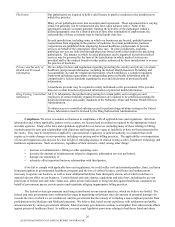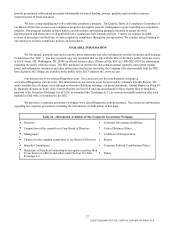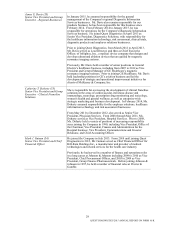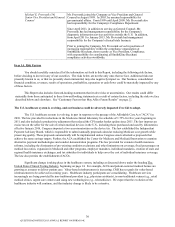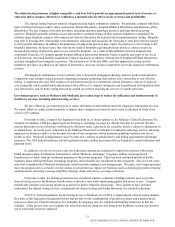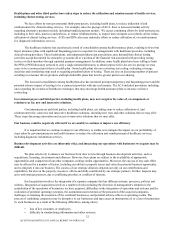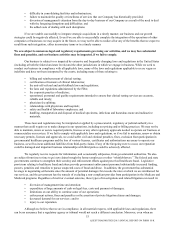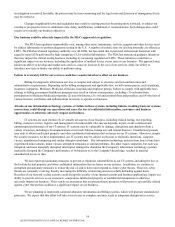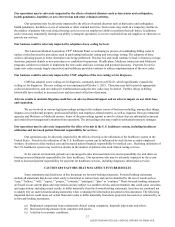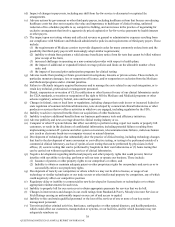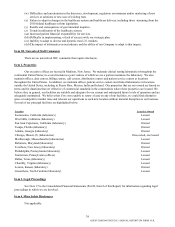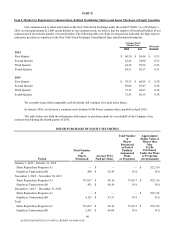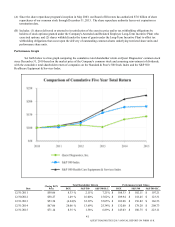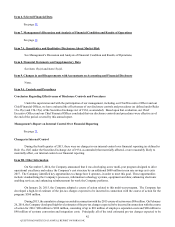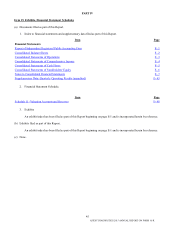Quest Diagnostics 2015 Annual Report Download - page 40
Download and view the complete annual report
Please find page 40 of the 2015 Quest Diagnostics annual report below. You can navigate through the pages in the report by either clicking on the pages listed below, or by using the keyword search tool below to find specific information within the annual report.36
We or our subsidiaries may incur additional indebtedness in the future. Our ability to make principal and interest
payments will depend on our ability to generate cash in the future. If we incur additional debt, a greater portion of our cash
flows may be needed to satisfy our debt service obligations and if we do not generate sufficient cash to meet our debt service
requirements, we may need to seek additional financing. In that case, it may be more difficult, or we may be unable, to obtain
financing on terms that are acceptable to us. As a result, we would be more vulnerable to general adverse economic, industry
and capital markets conditions as well as the other risks associated with indebtedness.
Our ability to attract and retain qualified employees is critical to the success of our business and the failure to do so may
materially adversely affect our performance.
Our people are a critical resource. The supply of qualified personnel may be limited and competition for qualified
employees is strong. We may lose, or fail to attract and retain, key management personnel, or qualified skilled technical or
professional employees (e.g., pathologists) at our clinical laboratories or research centers.
Failure to establish, and perform to, appropriate quality standards to assure that the highest level of quality is observed
in the performance of our diagnostic information services could adversely affect the results of our operations and
adversely impact our reputation.
The provision of diagnostic information services involves certain inherent risks. The services that we provide are
intended to provide information for healthcare providers in providing patient care. Therefore, users of our services may have a
greater sensitivity to errors than the users of services or products that are intended for other purposes.
Negligence in performing our services can lead to injury or other adverse events. We may be sued under physician
liability or other liability law for acts or omissions by our pathologists, laboratory personnel and hospital employees who are
under the supervision of our hospital-based pathologists. We are subject to the attendant risk of substantial damages awards and
risk to our reputation.
Our operations and reputation may be impaired if we do not comply with privacy laws or information security policies.
In our business, we generate or maintain sensitive information, such as patient data and other personal information. If
we do not adequately safeguard that information and it were to become available to persons or entities that should not have
access to it, our business could be impaired, our reputation could suffer and we could be subject to fines, penalties and
litigation.
We are subject to numerous political, legal, operational and other risks as a result of our international operations which
could impact our business in many ways.
Although we conduct most of our business in the United States, our international operations increase our exposure to
the inherent risks of doing business in international markets. Depending on the market, these risks include without limitation:
• changes in the local economic environment;
• political instability;
• social changes;
• intellectual property legal protections and remedies;
• trade regulations;
• procedures and actions affecting approval, production, pricing, reimbursement and marketing of services;
• exchange controls;
• attracting and retaining qualified employees;
• local market practices;
• export and import controls;
• weak legal systems which may affect our ability to enforce contractual rights;
• changes in local laws or regulations; and
• potentially longer payment and collection cycles.
International operations also require us to devote significant management resources to implement our controls and
systems in new markets, to comply with the U.S. Foreign Corrupt Practices Act and similar anti-corruption laws in non-U.S.
jurisdictions and to overcome challenges based on differing languages and cultures.
QUEST DIAGNOSTICS 2015 ANNUAL REPORT ON FORM 10-K


